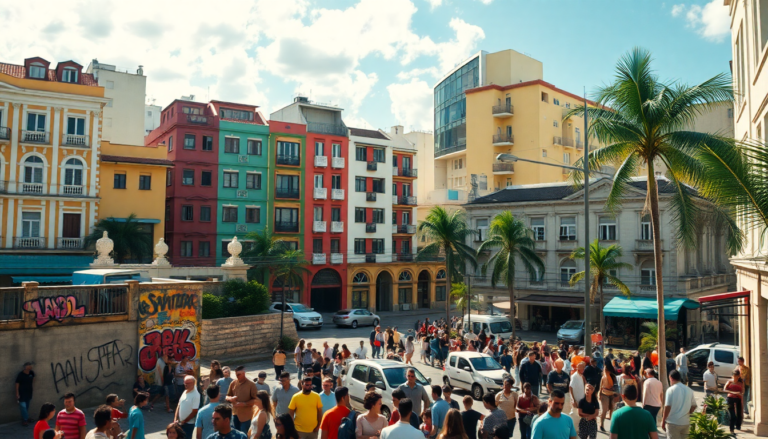Argomenti trattati
Travel is more than just visiting new places; it’s about experiencing the stories that those places tell. In the Brazilian film “O Agente Secreto,” director Kleber Mendonça Filho uses the backdrop of iconic cities like Recife, Brasília, and Paris not merely as settings but as active participants in the narrative. This film explores themes of identity, colonialism, and surveillance, all while weaving a rich tapestry of visual storytelling. Each location serves as a lens through which the audience can reflect on broader societal issues, making it a profound journey through both time and space.
The significance of Recife
Starting in the vibrant city of Recife, Brazil, the film captures the stark contrast between modernist architecture and urban beaches. Unlike typical portrayals of exotic destinations, Recife is depicted as a complex urban landscape, filled with a sense of history and ambiguity. The protagonist inhabits a 1970s apartment, complete with peeling walls and flickering neon lights, which encapsulates feelings of isolation and stagnation. This setting not only establishes a mood but also symbolizes the weight of the past that lingers in the present.
The verticality of Recife’s residential towers looms over the narrative, representing the watchful eye of authority. Drones and surveillance cameras capture every moment, while the true action unfolds at ground level, where individuals strive for autonomy amidst the system’s oppressive gaze. The film’s heart beats strongest in locations like Boa Viagem beach, where serene beauty contrasts with an underlying tension. Here, at dawn, the ocean transforms into a boundary between the protagonist’s internal struggles and the external world, setting the stage for pivotal encounters that will unravel his mission.
Brazil’s capital: Brasília
As the story unfolds, the protagonist travels to Brasília, a city synonymous with modernist utopia and political ambition. The film’s cinematography highlights the striking geometry of Oscar Niemeyer’s architectural designs, creating a dialogue between space and the themes of control and observation. The symmetry of the Palácio do Planalto and the National Congress frames the protagonist as a minuscule figure dwarfed by the monumental structures, emphasizing the isolation faced by individuals within a bureaucratic landscape.
In Brasília, silence reigns supreme. The absence of crowds amplifies the protagonist’s sense of alienation and paranoia as he navigates through empty streets and deserted squares. This auditory stillness enhances the tension, drawing viewers deeper into the protagonist’s psychological turmoil. A pivotal moment occurs in a hidden meeting room beneath the Palácio do Itamaraty, where he discovers a clandestine archive filled with recordings from the military dictatorship era. This revelation blurs the lines between past and present, showcasing how history continues to shape the political landscape in silence.
Lisbon: A cultural bridge
The narrative then shifts to Lisbon, Portugal, where the city serves as a cultural bridge between Europe and South America. The historic neighborhoods of Alfama and Mouraria become a labyrinth for the protagonist, embodying the intricate dynamics of espionage. The winding streets and narrow alleys echo with the potential for secrets and betrayals, as the protagonist attempts to decipher coded messages. A standout scene features him walking along the tracks of tram 28 at sunset, with a voiceover reading from a ciphered letter, further emphasizing the city’s role as a space of hidden truths.
Visual cues throughout Lisbon enhance this theme of duality. The film captures the neomanueline architecture and the scenic beauty of Belém, suggesting a deeper narrative beneath the surface. Each frame is meticulously crafted to evoke a sense of intrigue, encouraging viewers to ponder the complexities of identity and memory as they relate to the protagonist’s journey.
Paris: The depths of consciousness
The film culminates in Paris, where the narrative delves into the darker, subterranean aspects of the city. Departing from the well-trodden tourist paths, the protagonist explores the catacombs and abandoned metro stations, representing a quest for buried truths within the psyche of the city. These claustrophobic spaces, dimly lit and damp, create an unsettling atmosphere that mirrors the protagonist’s internal struggles.
In one haunting sequence, the protagonist follows an audio trail that leads him to a hidden listening room beneath Place Denfert-Rochereau. Here, the film encapsulates the idea of uncovering truths that lie beneath the surface of societal norms and expectations. The camera work is deliberate and intimate, drawing audiences into an almost psychological exploration of the character’s mind and the historical weight of the locations he traverses.
Reflection on the journey
“O Agente Secreto” is not just a film; it’s a visual odyssey that invites viewers to reflect on the intricate relationship between place and identity. Each city serves as a canvas, painting a complex portrait of power, memory, and the human condition. Kleber Mendonça Filho’s ability to intertwine personal and political narratives within these rich landscapes reveals the profound impact that our surroundings have on our stories. As the journey unfolds, it becomes clear that the true essence of travel lies not just in the destinations we visit but in the stories we uncover along the way.

